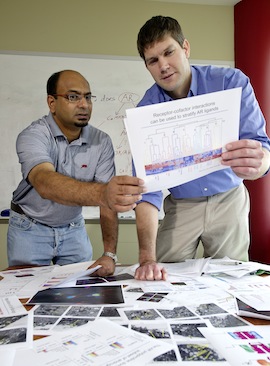NIH, DOD Grants to Fund Prostate Cancer, Diabetes Research at UH
Plans for $862K Include Expanded Uses for State-of-the-art Zebrafish Lab

“Success in today’s competitive federal funding landscape is validation of the motivation and ingenuity of our researchers,” said Dr. Jan-Åke Gustafsson, director of CNRCS. “With these new awards we are now able to explore new avenues of investigation into the treatment and prevention of these important diseases.”
The DOD awarded a grant of more than $337,000 this month to fund assistant professor Daniel Frigo’s project, “CaMKK beta-AMPK Signaling Axis as a Biomarker and Therapeutic Target for Advanced Prostate Cancer.” Prostate cancer, the second most common cancer in American men, is a major research focus of the Frigo laboratory. The award will further the team’s work with CaMKK beta-AMPK, a signaling pathway that may be an effective target for treating prostate cancer. The project is scheduled to begin by the end of June.
“Grants are critical to our research, not only for funding but also building and maintaining a reputable track record on the national level,” Frigo said. “Our team is eager to begin these new projects as we focus on identifying drug targets for possible clinical trials in the next phases of research.”

Gustafsson also was notified recently of another NIH grant that will support expanded uses for the center’s state-of-the-art zebrafish laboratory. The National Institute of Environmental Health Sciences awarded his team more than $375,000 to collaborate with UH computer science professor Ioannis Kakadiaris on diabetes and obesity research. The project is expected to be led by Maria Bondesson, a research assistant professor with the center. The project, “Detection of Obesogens and Diabetogens by Zebrafish Screening Models,” will entail screening the effects of chemical compounds that may disrupt the development of the endocrine system. It is widely hypothesized that exposure to certain chemical compounds in developed countries may be responsible for the steady increase in obesity and diabetes in the U.S.
In total, the CNRCS has 27 active grants. Overall, the center’s active projects account for more than $18 million in research funding at UH, another significant metric for Tier One status. Established in 2009, CNRCS is a focal point of the UH health initiative. The center’s investigators are involved in many aspects of nuclear receptor research and focused on understanding the roles of these receptors in health and disease. Cell signaling is part of a complex system of communication where cells signal each other to decide when to generate new cells. Errors in this processing are responsible for the diseases they study.
- Travis Coggin, CNRCS Communication, and Lisa Merkl, UH Communication